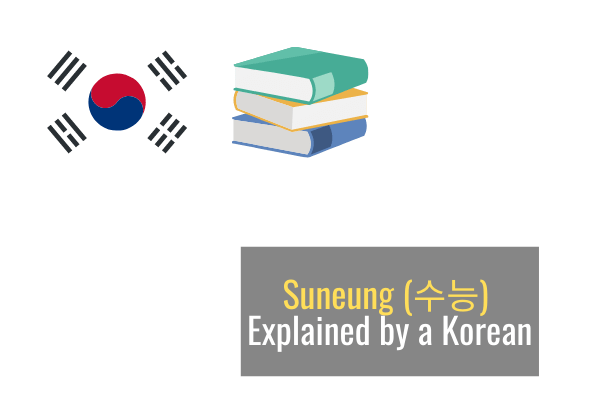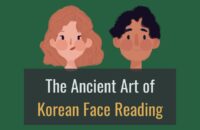This post covers the Suneung exam or Korean SAT and why it’s so important.
I go over the basics of the test, some interesting facts and things only Koreans know.

Quick Summary
- Suneung is College Scholastic Ability Test that means everything to Koreans.
- Suneung is the first and most important phase or goal in a Korean person’s life.
- Suneung is a 8 to 9-hour long marathon exam.
What is Suneung (수능) or CSAT?
Suneung is the Korean acronym for College Scholastic Ability Test (대학수학능력시험).
It’s like the SATs in the United States, but three times as long.
Suneung also has more weight in college admissions than the SAT.
To exaggerate a bit, CSAT results determine the futures of Korean students.
Why is Suneung so important in Korea?
Education has always been a top priority. But especially after the Korean War, the only way to escape poverty was through education. There’s even a proverb that covers this:
“개천에서 용 난다”
“a dragon rises from a small stream”
It means that a person from a poor background can become successful. Although more Koreans believe that this proverb is no longer applicable, since rich families spend way more money on education to send their children to top universities, the Suneung is still a fair exam.

What is the format of Suneung?
Suneung consists of multiple choice (5 options) and short answer questions (only for Mathematics). At the beginning of each test subject, inspectors hand out a large test booklet and OMR card answer sheet. The number of questions in each subject are:
- Korean (국어): 45 questions
- Mathematics (수학): 30 questions
- English (영어): 45 questions (the first 17 are listening questions)
- Korean History (한국사), Social/Science/Career Exploration (사회/과학/직업탐구): 20 questions
- Second Language/Chinese Characters (제2외국어/한문): 30 questions
This may seem manageable, but each question is a few paragraphs long. Time management is critical since you need to get through all questions and mark down the answers on a separate answer sheet.
What is the timetable and length of Suneung?
Suneung is a 8 to 9-hour long marathon exam.
Students should enter the exam room by 8:10 AM. To make this as smooth as possible, most Korean parents drop them off at the assigned school for the exam (which is different from their school to prevent cheating like hiding notes), or police escort them.
Banks and most companies open late on the CSAT day to minimize traffic.
Korean parents carefully prepare a lunch box for their children. Test takers avoid eating Miyeok-guk (미역국 or seaweed soup) on Suneung day since it’s slippery and will make them “slip” or fail.
There’s a double meaning here where Koreans can express 합격하다 or “pass” as 붙었다 or “stick”.
So, they want to eat something sticky like Yeot or Chapssal-tteok, not something slippery like Miyeok-guk to gain entry to the university of their choice.
During the English listening comprehension test after lunch, flights are grounded for ultimate silence.
Students can select one Second Language (제2외국어) from German, French, Spanish, Chinese, Japanese, Russian, Arabic, Vietnamese or Chinese Characters (한문). However, this subject is optional and not every university requires it.
When I took Suneung, I chose Arabic, even though I couldn’t read or understand it, just to get assigned to a better test site. Students aiming for top universities take a Second Language (제2외국어), so their exam environment is much better and quieter.
If you’re wondering how I answered the Arabic questions, I simply marked at random.
| Korean (국어) | 8:40 – 10:00 (80 minutes) |
| Break | 10:00 – 10:20 (20 minutes) |
| Mathematics (수학) | 10:30 – 12:10 (100 minutes) |
| Lunch | 12:10 – 13:00 (50 minutes) |
| English (영어) | 13:00 – 14:20 (70 minutes) |
| Break | 14:20 – 14:40 (20 minutes) |
| Korean History (한국사), Social/Science/Career Exploration (사회/과학/직업탐구) | 14:50 – 16:32 (102 minutes) |
| Break | 16:32 – 16:50 (18 minutes) |
| Second Language/Chinese Characters (제2외국어/한문) | 17:00 – 17:40 (40 minutes) |
10 interesting things about Suneung/CSAT
- No airplanes can take off or land during the English listening test. Flights on these routes need to maintain a holding pattern and circle around.
- Military training is stopped because guns and grenades going off are distracting.
- Stock markets open 1 hour later at 10 AM to reduce traffic.
- Most companies, including banks, open late to reduce traffic.
- Test takers who are running late can call 112 or 119 to get rapid transportation. 3,000 police cars and 200 fire trucks are on standby for the Suneung.
- Sick or injured test takers can contact their city or province office of education in advance to take CSAT in a hospital guarded by inspectors. If they’re sick on the day of Suneung, they may take their test at the school health center.
- All test takers are assigned to a different school to prevent cheating. If a student wants to go to the bathroom during the test, they need to raise their hand and tell the inspector quietly. The inspector in the corridor will scan their body with a metal detector and may accompany them to the bathroom.
- There are two inspectors (수능 감독관) in each classroom, usually the main one is a high school teacher and the supporting one is a middle school teacher. Inspectors need to arrive by 7:30 AM, and submit their mobile phones (and even smart car keys). It’s an extreme job since they need to supervise everything in the classroom and detect cheaters while staying completely silent. They get compensated with 140,000 won (about 130 dollars) at the end of the test.
- 300 exam writers (수능 출제자) consisting of high school teachers and university professors are selected in secret (writers are not allowed to talk about it) and locked in a secured place about a month before Suneung. No one knows the location. Agents of the National Intelligence Service cut all communication methods, including internet, and police officers guard the place. It’s completely separated from the outside world for a month. Even the garbage is disposed of after CSAT.
One time, exam creators played foot volleyball (족구), and a ball accidentally went over the wall. The security agents immediately ran to grab the ball and tore it to pieces to check, making exam creators very sad. They can only go outside when a direct family member passes away, but still, security agents will accompany them, and they need to return in half a day. They’re known to receive more than 10,000,000 won (about 9,222 dollars). This is to compensate them from being locked up for one month in a prison of sorts. - Suneung test papers are classified documents until the test day. The test papers are printed for about a week in a secure and guarded printing factory, then transported across the country on Monday. All transportation is guarded by police, and by the navy in remote places like Jeju Island. The test papers are distributed to each test site at 2 AM on the CSAT day. The truck drivers will be locked inside for a day and receive about 160,000 to 200,000 won (147 to 184 dollars).
More about teaching in Korea
Which items can students bring to Suneung?
Students need to bring their ID card (신분증) and test ID slip (수험표).
They can also bring:
- black pencil
- eraser
- sharp lead (0.5mm, black)
- white correction tape
- black computer marking pen (컴퓨터용 사인펜)
- analog watch without any communication or payment function, Bluetooth or LCD/LED display
Prohibited items are:
- mobile phones
- smart devices (smart watches)
- digital cameras
- electronic dictionaries
- MP3 players
- camera pens
- electronic calculators
- radios
- portable media players
- all electronic devices such as watches and electronic cigarettes
- earphones with Bluetooth functions
Since Suneung is very time-sensitive, Korean students use a stopwatch when studying and practicing for CSAT. (But they can’t bring one to the test.)
Which gifts do Koreans give to students taking Suneung?
Classic Suneung gifts are Yeot (sticky Korean traditional confectionery or 엿), Chapssal-tteok (Korean rice cake or 찹쌀떡 like Mochi), and chocolates (초콜릿).
For some reason, Ferrero Rocher is a go-to chocolate gift for Suneung takers in Korea.
I remember receiving a lot of these gifts before the test, but I was too nervous and careful to eat them the night before.
I only brought some chocolates to the exam to “sweeten up” my brain.
(Chocolate and sugar are known to help you focus in Korea.)
How hard is the Korean SAT?
If you’re fluent in Korean, you can check out 2020 Suneung questions and answers for 2021 college admission here.
Although difficulty fluctuates every year, I can say that it’s fairly hard.
Korean students need to not only study 7 to 9 subjects, but also manage their physical and mental condition while timing answers perfectly without making mistakes.
This one exam is the culmination of a Korea person’s childhood study from kindergarten to high school.
Other Suneung/CSAT FAQ
How do Korean students study so long?
Well, I just grew up doing it, so it felt natural to study all day. You can get used to anything if you have to. This experience taught me the importance of self-discipline and I’m glad I did it, although I hated it as a kid.
How many hours do Korean students sleep?
12th graders (고3) in Korea sleep 5.4 hours a day on average. I slept 6 hours and it was very normal.
Is life in Korea hard?
Yes. Childhood is very brief and then it’s off to intense study until they get to college. There, Koreans have freshman year to socialize and enjoy their youth before getting a job or men joining the military.
Why is it cold on Suneung?
For some reason, Suneung day has been always cold. Temperature drops to minus Celsius on CSAT and gets warm after. Some Koreans believe that test takers and their parents pray and call every type of ghost and spirit, including ancestors.
Just like in western countries, the presence of ghosts causes things to get colder in Korean culture.
Did we miss anything?
Suneung is an important part of growing up in Korea.
Now we want to hear from you.
Let us know your favorite Suneung fact in the comments!




where did you get suneung result?
Hi, thank you for asking.
I received my Suneung results from my high school.
You’ll receive the test result at the place you applied for suneung.
Most test takers (고3 or 12th grade) get results from their home room teacher at school, and repeaters (재수생) who take suneung again will receive them from either school they graduated from or Office of Education (교육지원청).
You can’t check suneung results online.
how long does it take for the suneung results to be released
Hi Janie, thank you for asking.
It usually takes about 3 weeks for students to receive test results.
This year, suneung will be on November 18th, 2021 and results will be given on December 10th, 2021.
I have a question and i hope someone can answer it. In goblin episode 6 at about 38 minutes sunny tells ji eun tak to get “100 points on her suneung” and then eun tak says that “if she gets 100 points she cannot go to college” and then sunny says “okay, get 1 or 2 wrong – the really hard ones” i did some research about the suneung to understand what she meant but to no avail – could you explain please ? Thank you so much !!!
Hi Maria, I love Goblin too!
Perfect score for Suneung now is 450 total. (When I took Suneung, it was 500 total, so the system keeps changing.)
Currently, it’s 100 for Korean, 100 for English, 100 for math, 50 for Korean history, 50 for second language/hanja, 50 for social/science/vocational exploration.
So, even with the changes in score system, if someone gets 100 points total, they won’t get accepted to college. 🙂
How many points is the suneung out of ?
Hi Maria, it’s out of 450 points now but might change in the future.
Hello! I was reading that the current perfect score for Suneung is 450 total, but what if you take more that one subject on social/science/vocational exploration? If you get most questions right, wouldn’t you get more than 450? 😮
Hi Hannah, that’s a good question!
Korean students can pick only one category out of social/science/vocational exploration, then up to two subjects within that category.
So, the total score of 450 will be the same 🙂
Can foreigners take the suneung
Hi Andri,
Yes, you can apply to take the suneung, but there are many “ifs”.
You need to have graduated from a high school in Korea; passed a qualification examination in Korea (equivalent of GED); or completed 12-year (elementary, middle and high school) education with a high school diploma overseas.
Can international students admit to Korean medical universities to become a doctor by taking suneung??
Hi again Andri,
Yes, you can gain admission to Korean medical universities, but suneung is extremely competitive. You might want to look into 외국인전형 (international student).
For this type, each university has different requirements, but mostly requires you and both your parents to be non-Korean.
They have their own tests including document evaluation and interview. Most schools also require TOEFL or TOPIK scores.
Best of luck!
Is there an age requirement to take the suneung?
If not, what is the youngest known age of someone taking the suneung?
Are the scores ever published publicly or publicized?
Thanks
Hello Yelena,
There’s no age requirement to take the suneung. They just need to be about to graduate high school (고3), have graduated from high school, or have the equivalent of a high school diploma.
The youngest age I found was 13 years old (Korean age).
As far as I know, suneung score is private, except for those with perfect scores.
Let’s say you’re a 14/15 year old foreigner, who just moved to South Korea. Can’t speak korean, non- korean parents. How are you then expected to take the test?
Thank you!
Hi Maria,
In that case, I wouldn’t recommend taking Suneung. Korean (국어) subject is difficult even for Koreans fluent in the language.
If you wish to go to a university in South Korea, you can instead look for a 외국인 전형 (special admissions plan for international students).
Best of luck!
What percentage of students take this exam?
Hi Jen,
That’s an interesting question.
For the percentage of students taking the test/number of applicants,
it used to be above 90% up until 2017, with the highest percentage of 97.5% in 2000.
Then, the percentage seems to be declining and 2021 was 87.9%.
Hope this data helps!
How many times can you take this exam? If you fail once can you apply the next time?
Hello Parisa,
You can take Suneung every year, as many times as you like.
There’s no failing score. You can always apply again and take it next year (it’s quite common for Koreans to take it again).
Hope this answers to your question. ^^
I wanna study in korea , do GKS scholarship pays for 4 years of university or just one? Is the scholarship exam hard? Which subjects come into the exam?
(i know it has nothing to do with Suneung but I will be really grateful if you answer this)
Hi Pari,
I don’t know much about the GKS scholarship, but I found this website in English.
Hope this helps!
Heyy! I was wondering that if you complete gr12 in a different country and wish to go to a uni at korea, then do u take the suneung? if not what would you have to do? And would it be hard?
Hi Aera,
Yes, you could take suneung, but it would be very hard for non-Koreans. (Korean kids study their whole life for this test.)
Perhaps, you can look for a 외국인 전형 (special admissions plan for international students) to go to a university in South Korea.
Best of luck!
My mom is a Korean adoptee. Therefore I spent 12 years of my education in America and plan to enroll in university in Korea.
However since i am technically going to have dual citizenship from my mom being Korean, i am not eligible for the international student track.
Therefore i can’t find any information on how to apply. Do i apply as a normal korean citizen? Do i have to take the suneung or do american SAT scores matter? Or is there another way of applying as an overseas korean?
Hi Aj,
That’s a good question. Going to uni in Korea can be super fun.
I think you should look into the 재외국민 전형 (Overseas Korean Track) or 전교육과정 해외 이수자 (those who have completed 12-year education overseas).
Each school is different, but most require a personal statement, academic transcript, awards, extracurricular activities, etc. (I checked Yonsei and Sogang as they showed up first online.)
Best of luck! ^^
Can a foreigner apply for suneung exam even though they did not attend a Korean high school?
Hi,
You can apply to take the suneung, but there are many “ifs”.
You need to have graduated from a high school in Korea; passed a qualification examination in Korea (equivalent of GED); or completed 12-year (elementary, middle and high school) education with a high school diploma overseas.
what is top score a student has ever got in this exam…..are suneung score applicable in all undergraduate cources in any college in south korea….and lastly what is the syllabus for this exam….?
Hi Shristi,
There are usually a few students getting a perfect score or full marks (400), but probably not this year.
Suneung score is applicable to any university in Korea.
You can find the subjects in this article. They include Korean, Mathematics, English, Korean History, Social/Science/Career Exploration, and Second Language/Chinese Characters.